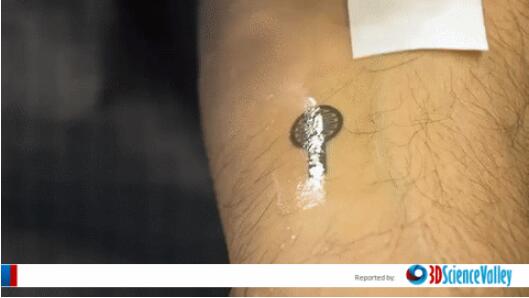Researchers from the School of Engineering of Carnegie Mellon University and the Institute of Systems and Robotics at the University of Coimbra in Portugal have developed a simple and effective method to create rugged, highly flexible tattooed circuits for wearable computing.Scientists use low-cost3D printingThe process prints conductive liquid metal alloy onto tattoo paper attached to human skin. These ultra-thin tattoos can be easily dipped in water, just like applying a wet sponge to a child’s decorative tattoo.

Carnegie Mellon University
Make the circuit more conformable
![]() Low-cost processing of electronic “tattoos”
Low-cost processing of electronic “tattoos”
The research results were published in a paper in Advanced Materials. In addition to low-cost processing, these tattoos have other advantages. Because they have mechanical properties similar to lightweight fabrics, they remain functional under bending, folding, twisting, and strains of more than 30% (this is the typical stretchability of human skin). They can be attached and attached to highly curved 3D surfaces, such as human brains or lemon models. Applications of ultra-thin, compliant electronic tattoos include epidermal biological monitoring, soft robots, and flexible displays.
Carnegie Mellon University
Other electronic products like tattoos either require complex manufacturing techniques inside the clean room or lack the material properties required for stretchable digital circuit functions on the skin. Carnegie Mellon University’s associate professor of mechanical engineering and director of the soft machine laboratory Carmel Majidi (Carmel Majidi) opened a new way to make stretchable electronic circuits in an economical way.
In 2018, Professor Majidi and his team also created a self-repairing circuit that can continue to work even after the main path is cut off or damaged. They created a material made of liquid metal that can also physically repair damage. When two pieces of liquid metal electrical composite material are placed together, they fuse together like self-healing. This innovation allows circuits to withstand greater damage because they can simply repair themselves.Carnegie Mellon University also uses silicone elastomers to pass3D printingTechnology has developed a wearable pulse oximeter with pressure sensing function.Based on anatomical scans of the fingers or toes, through3D printingManufacture a soft cuff for patients and integrate it with flexible electronic equipment to calculate heart rate, blood oxygen content and activity status.
About direct writing3D printingTechnology, the United States Lawrence Livermore National Laboratory LLNL has developed a new metal3D printingTechnology Research Project



0 Comments for “Carnegie Mellon University 3D prints stretchable and wearable electronic “tattoo””